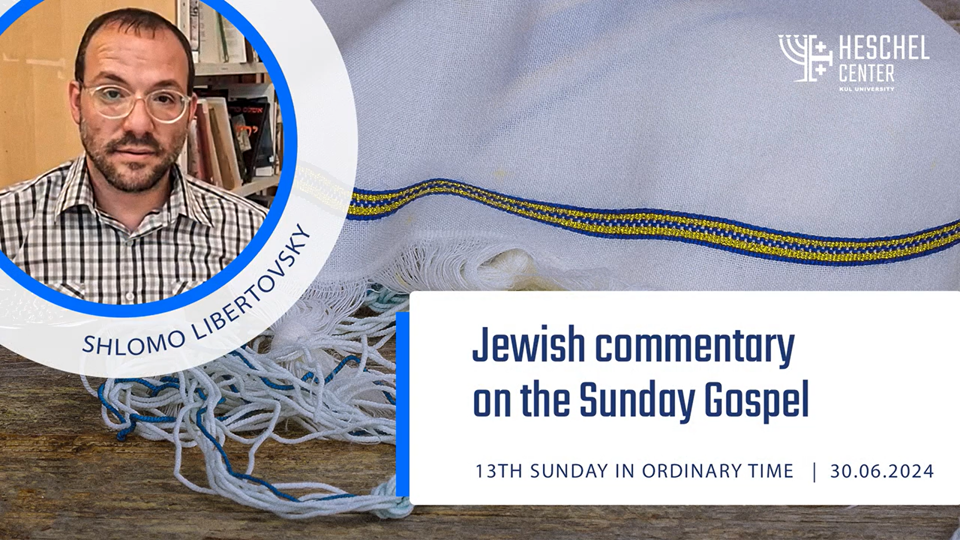The Commandment of Tzizit: From the Time of Jesus to the Present Day
“In Mark 5 we read about a woman who had suffered from hemorrhage for many years. She was instantly healed when she touched the hem of Jesus’ garment. The hem of the garment is not a coincidental description. At the time of Jesus, it was customary in Jerusalem and Jewish towns in the north of […]

“In Mark 5 we read about a woman who had suffered from hemorrhage for many years. She was instantly healed when she touched the hem of Jesus’ garment. The hem of the garment is not a coincidental description. At the time of Jesus, it was customary in Jerusalem and Jewish towns in the north of the country to observe the biblical mitzvah of tzitzit.” stresses Shlomo Libertovsky, a Torah lecturer at Beth Shemesh, in a commentary for the Heschel Center of the Catholic University of Lublin’s, for Sunday, June 30.
In Mark 5 we read about a woman who had suffered from hemorrhage for many years. She was instantly healed when she touched the hem of Jesus’ garment. The hem of the garment is not a coincidental description. At the time of Jesus, it was customary in Jerusalem and Jewish towns in the north of the country to observe the biblical mitzvah of tzitzit.
In the Book of Numbers 15,38-39 we read: “Speak to the Israelites and tell them that throughout their generations they are to make tassels for the corners of their garments, fastening a violet cord to each corner. When you use these tassels, the sight of the cord will remind you of all the commandments of the LORD and you will do them, without prostituting yourself going after the desires of your hearts and your eyes”. The commandment appears for the second time in the Book of Deuteronomy 22, 12: “You shall put tassels on the four corners of the cloak that you wrap around yourself”.
The meaning of the word “tassel” is “a bundle of threads that hang down from one end”. The verse 38 in Numbers indicates that there is a requirement that one bunch of the threads be light blue when “making the tassel”. According to the tradition, the blue color was to be obtained from a certain type of sea snail. At the beginning of the Muslim era in the land of Israel, the dyeing of the threads in blue ceased completely. Men continued to wear tassels but without light blue threads because the Halacha stated that “light blue does not interfere with white”. In the 19th century, the tradition of dyeing the threads blue began to return, and today some religious Jews wear a tassel in which the colour blue is woven into the white threads.
The meaning of this mitzvah, as written in the commandment from the verses already mentioned, is that it is a person’s duty to remember this commandment and not to stray after their heart and eyes, as was the case with the spies (Numbers 13) who followed their eyes during their journey through the land. This in turn caused them to deviate from the path of God and made them forget His commandments. Another explanation is that slaves used to wear on them a symbol of their master and so Israelis wear a tassel as a symbol of belonging to God and to show that they are His “slaves”.
The sages of the Mishnah and the Talmud even said that the light blue colour of the tassel evokes the sight of the sea, the sky and the throne of the Almighty in a person’s mind. In this way it protects him from sin. They also explained that the tassel symbolises that the Jew belongs to the People of Israel. When we look at it, we remember God.
In the Talmud, in tractate Minchot (Daf 44), there is a story about a man who was very careful to wear a tassel, as was the custom. One day he heard that there was a prostitute in a nearby town. She took 400 gold coins from men who came to her room. The man sent her 400 and arranged to meet her. When it was his turn to spend time with her, he entered her room. As he undressed, he felt the four tassels touch his face. He immediately backed away from her and sat down on the floor. She asked him why he withdrew and would not touch her. The man replied to her: “I have never seen a woman as beautiful as you in my life. But my eyes noticed the tassel I was wearing and it reminded me of the commandment of the tassel, which is supposed to remind us to avoid sin!
In the books of Jewish mysticism (“Books of the Kabbalah”), the tassel is also considered to be an aid to deliverance from trouble and dangerous situations. Indeed, in the recent war in Gaza, thousands of soldiers, including those who are not religious, wear a tassel, hoping to be saved from danger on the battlefield.
About the author:
Shlomo Libertovsky – a Torah lecturer at Beth Shemesh and a member of Nostra Aetate 4 in Jerusalem, an ecumenical organization dedicated to Jewish-Catholic dialogue.
Related

A Meeting of Hope in St. Peter’s Basilica: Trump and Zelensky
Exaudi Staff
27 April, 2025
2 min

Saying Goodbye to Francis
Exaudi Staff
26 April, 2025
2 min

The Family: A School of Love, Forgiveness, and Hope
Laetare
25 April, 2025
3 min

Pope Francis: Leadership That Transforms Through Service
Javier Ferrer García
25 April, 2025
4 min
 (EN)
(EN)
 (ES)
(ES)
 (IT)
(IT)

